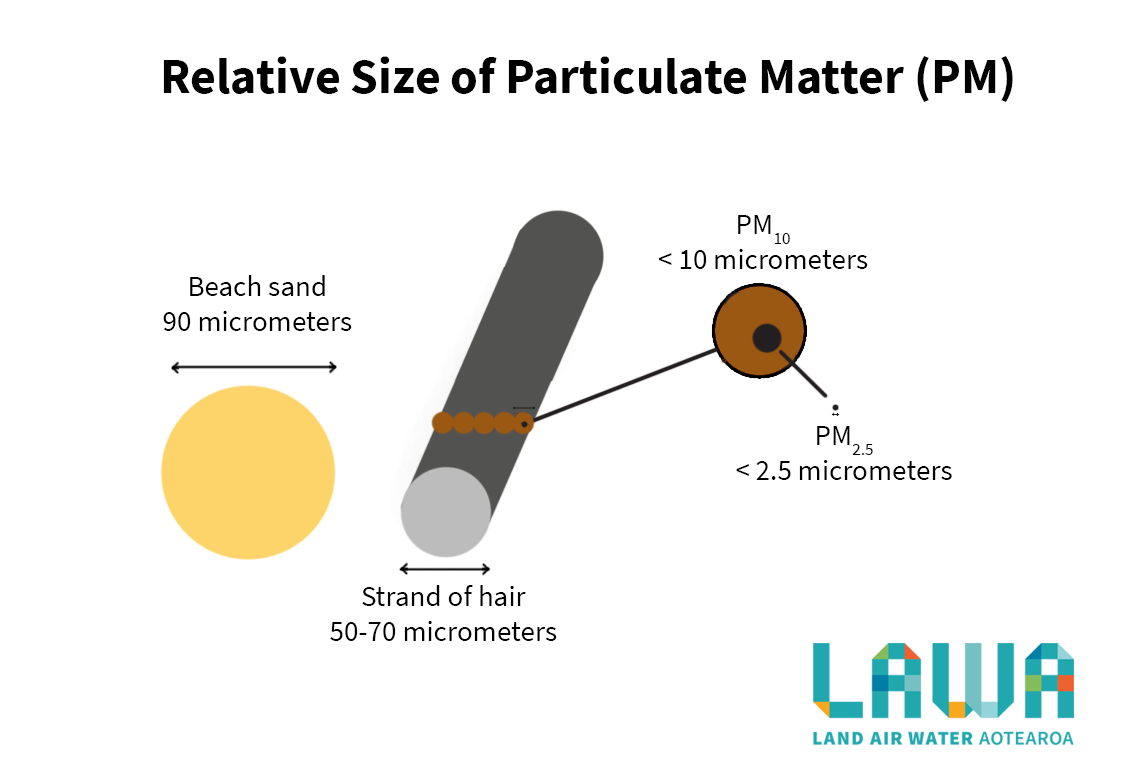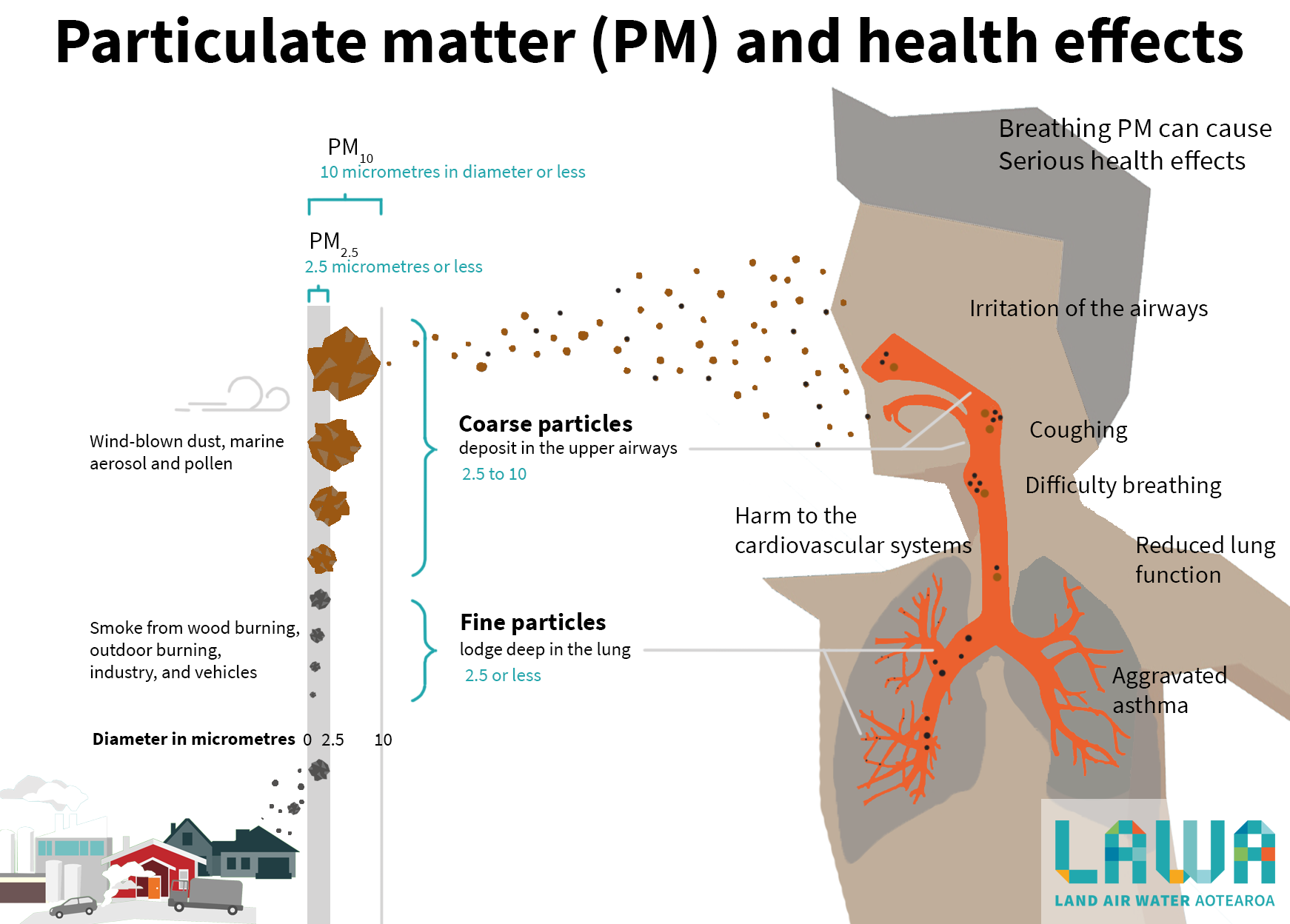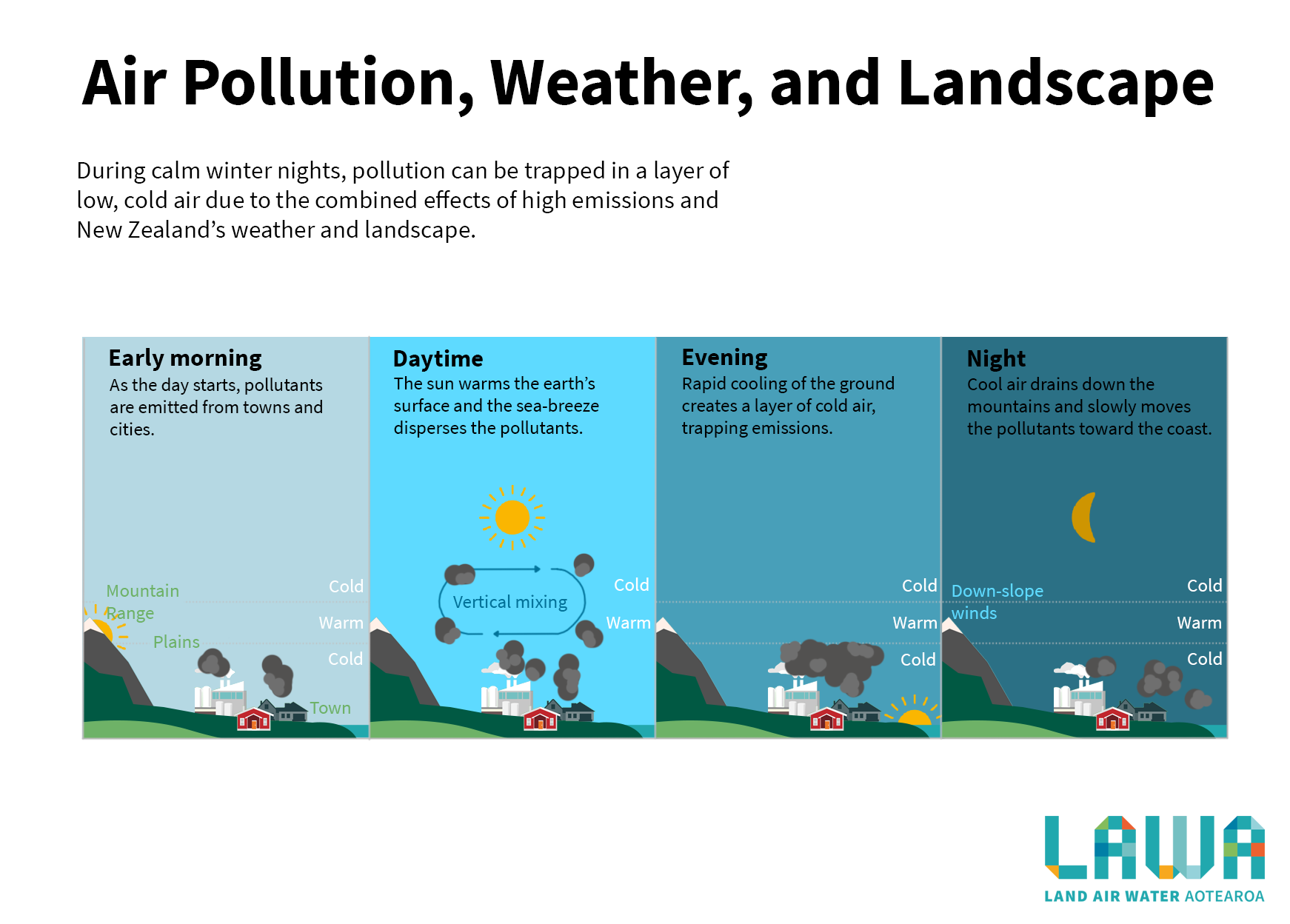We all need clean air
Good outdoor air quality is fundamental to our well-being. On average, a person inhales about 14,000 litres of air every day, and pollutants in this air can adversely affect people’s health. People with pre-existing respiratory and heart conditions, the young, and older people are particularly vulnerable.
Air quality can also indirectly affect our economy through its impact on people’s health, for instance, higher medical costs and lost productivity through absence from work. It also affects the environment. When air pollutants settle on land or waterways, or wash into waterways, they can pollute these environments. Certain air pollutants can also affect our climate. Some have a warming effect while others have a cooling effect.
(Source: https://environment.govt.nz/publications/environment-aotearoa-2015/)
Air and air quality are both a taonga and part of the kaitiakitanga for Maori.
Scientific indicators for air quality
Our air quality is affected by many substances produced by human activities (e.g., burning of fuels) and by natural sources (e.g., volcanic eruptions, windblown dust, pollen and sea salt). Air pollution is therefore a complex mixture of gases and particles arising from many different sources. In order to assess air quality we measure the concentration of specific air quality indicators that have known health impacts and compare these to standards and guidelines, for more information see Factsheet: Monitoring air quality in New Zealand. These indicators include different sizes of airborne particles (i.e. PM10 and PM2.5) and gases such as carbon monoxide, nitrogen dioxide, sulphur dioxide, ozone and benzene.
Airborne particles
Airborne particles are generated by human activities, and arise from natural sources. Common activities that lead to particles being released into our air include, burning wood for home heating, vehicle exhausts (particularly diesel), road dust and quarrying. Natural sources include sea salt, pollen and wind-blown soil particles, including liquefaction dust. Collectively all airborne particles are called particulate matter abbreviated to PM. To enable us to compare measurements, better understand health impacts and manage the levels of PM in air, we commonly classify particles by their size:
-
PM10 particles are smaller than 10 micrometers (µm) across
- PM2.5 particles are smaller than 2.5 micrometers (µm) across.
The diagram below compares the size of PM10 and PM2.5 particles to a strand of hair and a grain of fine beach sand. They are tiny – too small for the human eye to see. Note that PM10 includes the smaller PM2.5 particles.

The size of particles is also important for health impacts. Generally the larger sized particles (between 2.5 µm and 10 µm) when breathed in remain in the upper airways. Whereas smaller particles (PM2.5 and smaller) can lodge deeply in the lungs and even enter the bloodstream. The PM2.5 particles are typically produced by human activities, such as burning of wood and fossil fuels.
In the short term PM10 mainly affects people’s lungs and heart, ranging from reduced lung function, impaired activities (e.g., sick days off school or work), more doctors’ visits and hospital visits. Long term effects are reduced life expectancy. Large studies overseas that have looked at impacts of PM10 on population health have not been able to reliably identify a level of PM10 in air below which there are no adverse health effects. In New Zealand, all regional councils and unitary authorities measure PM10 and some also carry out PM2.5 monitoring.

Gases
Gases can also adversely affect our air quality and people’s health. We have good information on nitrogen dioxide concentrations in New Zealand based on monitoring carried out by the New Zealand Transport Agency (NZTA). Some regional councils and unitary authorities also measure nitrogen dioxide. Nitrogen dioxide concentrations are an indicator of air pollution from road motor vehicles. Exposure to nitrogen dioxide is linked to an increase in asthma symptoms and reduced lung function. Other gases, such as carbon monoxide, sulphur dioxide, benzene and ozone, are also monitored by some regional councils and unitary authorities at some sites in New Zealand.
What influences air quality?
The level (or concentration) of pollutants in the air at any given time depends on the quantity of pollutants being released into the air (known as emissions), and whether these emissions are being dispersed by winds or removed by rain. Windy conditions can quickly disperse the emissions of fine particles and gases, preventing the accumulation of air pollutants, whereas still conditions do not disperse air pollutants leading to a build-up in areas where pollutants are being released. However, in some cases, windy conditions can also lead to higher levels of the larger sized particles in the air, for example, when sea salt is blown inland or settled dust is re-suspended.
In some small towns in New Zealand, particularly in the South Island during winter time, a temperature inversion can form creating a layer of warm air that traps cooler air and any air pollutants underneath. These most often occur in towns situated in valleys or basins, where night time temperatures are low, and there is no wind. The combination of higher levels of air pollutants being emitted and trapped, leads to poor air quality in these towns.

How is air quality managed?
Under the Resource Management Act, regional councils and unitary authorities are responsible for managing outdoor air quality. Regional councils must also ensure the national environmental standards for air quality (NES-AQ) are met within their regions. The NES-AQ set limits in outdoor air for PM10, carbon monoxide, nitrogen dioxide, sulphur dioxide and ozone and require councils to monitor areas where these are likely to exceed those limits. Most council air quality monitoring programmes focus on measuring PM10 as this is the pollutant that most often approaches high levels.
Councils can use several different tools to meet the requirements of the Resource Management Act and air quality standards. They can establish policies and rules to manage particular issues in their regions, issue resource consents for discharges from industrial and trade premises, carry out education campaigns and provide incentives for people to use cleaner forms of home heating.
For more information on steps you can take to help reduce air pollution see Factsheet: Tips on improving air quality.
Council monitoring is used to track whether levels of PM10 are reducing in response to council policies and rules designed to lower emissions from home heating. Many council air quality monitoring sites also include meteorological measurements, such as wind speed and direction and temperature. This allows councils to better understand whether air quality is improving or getting worse, or, for example, just being affected by the wind. Ongoing monitoring of air quality in areas where pollutants can be a problem lets councils know if their policies and rules, education campaigns and incentive programmes are working.
Why estimate emissions?
As well as tracking changes in concentrations of air pollutants using monitoring equipment councils also carry out emission inventories to estimate whether the air pollutant emissions produced by home heating, industry and transport are changing over time, and whether these changes can explain air quality trends. Emission inventories are usually prepared using survey methods to find out how much fuel (e.g., wood, coal, petrol and diesel) is being burnt in a given area and then applying an emission factor to calculate how many kg of an air pollutant is released per day or tonnes per year for that area.
Where do I find more information?
Check with your regional council or unitary authority for more on air quality for your region.
